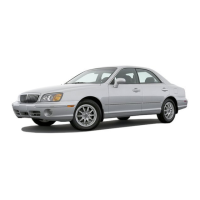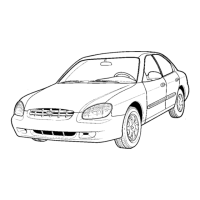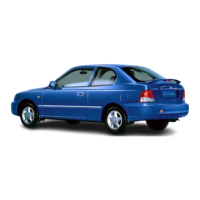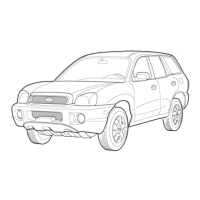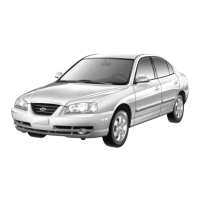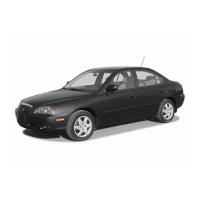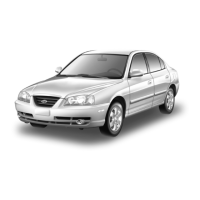Do you have a question about the Hyundai 2001 Elantra and is the answer not in the manual?
Details the limited warranty coverage for new Hyundai vehicles.
Outlines the specific warranty for the vehicle's powertrain for the first owner.
Details warranty coverage for emission-related components and systems.
Highlights the owner's duty to perform specified maintenance operations at intervals.
Welcomes the owner and introduces the manual's purpose and benefits.
Advises against modifications that may affect performance, safety, or warranty.
Explains the meaning of WARNING, CAUTION, and NOTE titles in the manual.
Explains what genuine parts are and why they should be used for optimal performance.
Provides guidance on appropriate gasoline types and usage for Hyundai vehicles.
Details the vehicle's key system, including spare keys and key number recording.
Explains the operation of door locks, including safety warnings for child occupants.
Describes the function and use of the child-protector lock on rear doors.
Outlines the function and stages of the vehicle's theft-alarm system.
Covers the operation and safety precautions for adjusting front seats.
Provides essential warnings and recommendations for proper seat belt usage.
Overview of the SRS system, its components, and general operation.
Provides an overview and identification of the vehicle's various instruments and controls.
Explains how to read the engine coolant temperature gauge and what to do if it overheats.
Overview of the cruise control system for automatic speed management.
Overview of control types (A and B) for automatic climate control systems.
Explains how car audio systems receive and process radio signals.
A chart listing audio system fault indications, causes, and solutions.
Critical safety warning about the dangers of engine exhaust fumes and proper ventilation.
Essential checks to perform before starting the vehicle's engine.
Explanation of the automatic transaxle's positions (P, R, N, D, 3, 2, L).
Essential advice for safe and effective braking, including hill descents and slippery conditions.
Explains the function of the ABS system in preventing wheel lock-up during braking.
Details the TCS system's role in limiting wheel spin and improving traction.
Tips for improving fuel economy through smooth driving and proper vehicle maintenance.
Recommendations for driving safely in winter conditions, including tire and coolant checks.
Legal requirements and considerations for towing trailers or other vehicles.
Troubleshooting steps when the engine fails to start or turns over slowly.
Detailed instructions and safety warnings for jump-starting a vehicle's battery.
Procedures to follow if the engine overheats, including stopping and checking components.
Steps to take when a tire becomes flat while driving.
Step-by-step guide for changing a flat tire, including obtaining tools and blocking wheels.
General advice and cautions for towing a vehicle correctly to avoid damage.
Information on obtaining replacement keys and opening doors if keys are locked inside.
Importance of owner cooperation for long-term corrosion resistance.
Identifies common factors contributing to vehicle corrosion.
Proper techniques for washing and waxing the vehicle to protect the finish.
Importance of maintenance procedures for Hyundai vehicle operation and warranty.
Maintenance services to ensure emission control and performance, with mileage/time intervals.
Lists maintenance items that require more frequent service under severe driving conditions.
Explains the required maintenance for specific items like engine oil, fuel filter, and drive belts.
Diagram identifying major components in the engine compartment for DIY checks.
Importance of checking engine oil level and condition regularly.
Procedure for changing the engine oil and filter at specified intervals.
Importance of checking and changing engine coolant, with safety warnings.
Detailed instructions for changing spark plugs, including safety precautions.
How to inspect, clean, and replace windshield wiper blades.
Importance of checking manual transaxle oil level and recommended fluid type.
Suggests periodic checks and inspections of the vehicle's brakes by a dealer.
Guidance on keeping the air conditioning condenser clean.
How to check for excessive free-play in the steering wheel.
Instructions for checking drive belts for cracks, wear, and proper tension.
Steps for locating and replacing blown fuses for accessories.
Precautions and steps for working with vehicle batteries, including fluid handling.
How to check the power steering fluid level and notes on cold weather noise.
Procedures for adjusting headlight aim after body repair or replacement.
Overview of the emission control system and its three main components.
Explains the PCV system for preventing blow-by gases from polluting the atmosphere.
Details the system designed to prevent fuel vapors from escaping into the atmosphere.
Describes the system that controls exhaust emissions for better vehicle performance.
Information on the catalytic converter's role in reducing exhaust emissions.
Guidance on maintaining proper tire inflation pressures for optimal performance and safety.
Locations of the VIN and its importance for registration and ownership.
Information on the tires supplied with the Hyundai for normal driving performance.
Explains the comparative quality grades for tires, including treadwear, traction, and temperature.
How to inform NHTSA and Hyundai about vehicle defects that could cause crashes or injuries.
Provides key vehicle measurements such as length, width, wheelbase, and wheel tread.
Details the type, free play, rack stroke, and oil pump type for the power steering system.
Specifies the standard tire size and related information.
Lists specifications for the vehicle's battery and alternator.
Details the type of brake system, front/rear brake types, and parking brake.
Provides the fuel tank capacity in US gallons, Imperial gallons, and liters.
Details engine type, idle speed, spark plug type and gap, valve clearance, and timing.
A chart detailing oil and fluid types, quantities, and service intervals for various vehicle components.
Details about unleaded gasoline requirements and recommended octane rating.
Recommended engine oil types (API SG, SH, SG/CD) and viscosity grades for different climates.
Information on manual transaxle oil level checking and recommended fluid type.
Procedure for checking automatic transaxle fluid level and recommended fluid types.
| Brand | Hyundai |
|---|---|
| Model | 2001 Elantra |
| Category | Automobile |
| Language | English |

